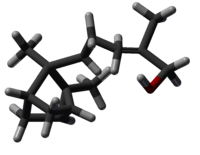α-Santalol
-alpha-santalol.svg.png) | |
 | |
| Names | |
|---|---|
| IUPAC name
(Z)-5-(2,3-Dimethyltricyclol[2.2.1.02,6]hept-3-yl)-2-methylpent-2-en-1-ol | |
| Identifiers | |
| 115-71-9 | |
| 3D model (Jmol) | Interactive image |
| ChemSpider | 16736011 |
| ECHA InfoCard | 100.003.730 |
| EC Number | 204-102-8 |
| |
| Properties | |
| C15H24O | |
| Molar mass | 220.36 g·mol−1 |
| Appearance | Liquid |
| Density | 0.9770 g/cm3 |
| Boiling point | 166 °C (331 °F; 439 K) |
| Practically insoluble | |
| Solubility in ethanol | Soluble |
| Solubility in diethyl ether | Soluble |
| Chiral rotation ([α]D) |
+10.3° |
| Refractive index (nD) |
1.5017 |
| Related compounds | |
| Related terpeness |
β-Santalol |
| Except where otherwise noted, data are given for materials in their standard state (at 25 °C [77 °F], 100 kPa). | |
| Infobox references | |
α-Santalol is an organic compound that is classified as a sesquiterpene. It comprises about 55% of the oil of sandalwood, another less abundant component being β-santalol. As of 2002, about 60 tons of sandalwood oil are produced annually by steam distillation of the heartwood of Santalum album. It is a valued component for perfumes.[1]
The oil content varies greatly within the different sandalwood species. This level is typically highest in the album, paniculatum and yasi. The scent profile also changes considerably between the different species' oils.
References
- ↑ Karl-Georg Fahlbusch, Franz-Josef Hammerschmidt, Johannes Panten, Wilhelm Pickenhagen, Dietmar Schatkowski, Kurt Bauer, Dorothea Garbe, Horst Surburg "Flavors and Fragrances" in Ullmann's Encyclopedia of Industrial Chemistry, Wiley-VCH, Weinheim: 2002. Published online: 15 January 2003; doi:10.1002/14356007.a11_141.
This article is issued from Wikipedia - version of the 1/19/2016. The text is available under the Creative Commons Attribution/Share Alike but additional terms may apply for the media files.